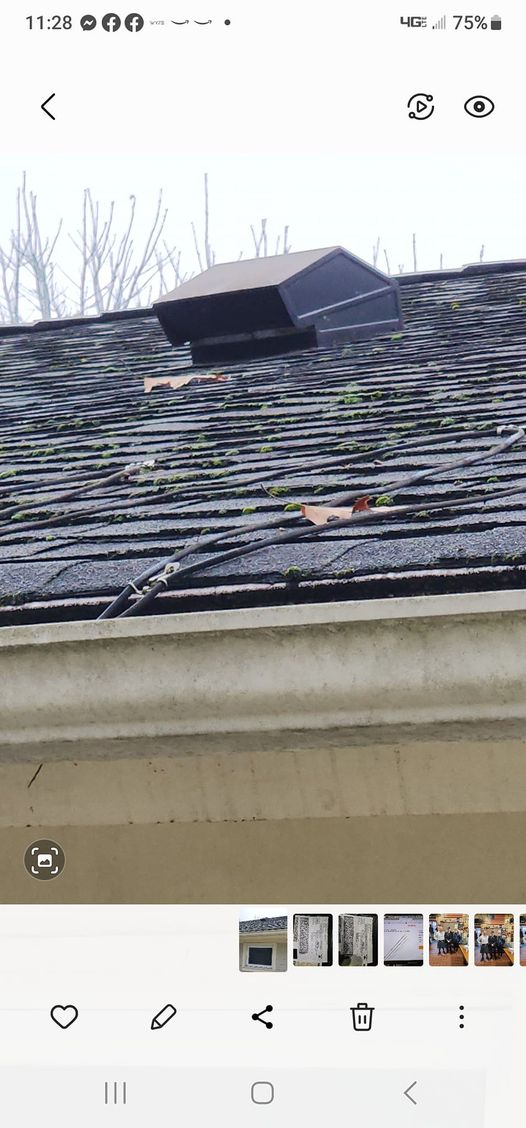How can I identify and fix the source of a long-standing exhaust leak causing water to seep under the shingles and emerge at the plywood seam?
8 months ago
Last Updated: October 12, 2024
I put in this exhaust a while back, and now it’s got a leak. How would you go about figuring out what’s wrong? When I checked the attic, everything seemed dry. The water must be sneaking in under the shingles and showing up at the next plywood seam.

It really depends on how they appear on the roof from where you’re standing. Can’t tell much from this angle.
Edit: The shingles seem to have moss and are starting to come loose. It might be a good idea to get a new roof, or at least a thorough cleaning and inspection.
Hey buddy, those shingles are looking quite worn out. Might be time for new ones.
It’s probably about time to get some new shingles, and make sure they’re not stacked on top of each other.
Has it been leaking constantly or only after the temperature change? Maybe because it’s a single-story house, the issue is on the northern side where the bathroom vent is located. If the duct isn’t insulated as it passes through the unconditioned attic, moisture might condense and cause leaks indoors. Cold air is usually dry, while warm air is humid. It’s similar to how a cold glass of water sweats on a hot day. This is what can happen to exhaust ducts if they’re not properly insulated and experience sudden temperature changes.
Apply silicone around the top three sides, and leave the bottom untouched.
Check around the vent for any loose nails or flashing, and make sure to seal them with outdoor sealant.
Do you have any clearer photos? Another option could be running LEXEL underneath the shingles
By the way, a well-insulated attic shouldn’t necessitate the use of those heat cables
Honestly, I originally mistook this for yet another cyber truck post
‘t forget to address the moss on your roof as well. Consider adding a zinc strip to both sides of the peak to prevent the moss from returning.
You could consider hiring a professional to handle it while they’re replacing the shingles. If it’s flashed correctly, there shouldn’t be any leaks.
Maybe just recaulk for the time being until you’re able to redo the shingles on your roof.
If your roof appears old, be sure to seal around it using roofing cement.
Flex Seal MAX comes in a 2-Pack of 17 oz cans in Black. It instantly stops leaks with its waterproof rubber spray on sealant coating. Ideal for various uses like gutters, wood, RVs, campers, roof repairs, skylights, windows, and more. Get it at https://a.co/d/1u8Thmh
Make sure to inspect the flashing and then seal it properly.
Try using ‘Through the Roof’ on it.
If there’s a leak, you may need to apply caulk, but considering the roof pitch isn’t very steep, caulking should suffice. When installed properly, there should be no leaks. The roof pitch seems to be around 4/12, so not much can be done except having a roofer reinstall it correctly. The bottom flange should overlap the shingle at the bottom. As a roofer with 45 years of experience, I’ve never been a fan of leaving the flange exposed at the bottom. However, it can still be installed discreetly to ensure water shedding.
It appears the bottom edge is tucked under the shingles in this photo, which is not correct. Remember, the top edge should go under while the bottom edge should go over. Apply sealant under the top and sides, but not the bottom.
Alright, here’s yet another post that is riddled with more problems than a leaky vent. Have you ever wondered why there are plants or moss thriving on the shingles? This is a first for me. If it were up to me, I’d say we tear off the entire roof and begin anew…
It’s pretty common in wetter areas such as Oregon and Washington. Removing and treating it is not difficult.
I can’t help but think of the Cybertruck every time I see this 😅
Take off the shingles from all sides and apply butyl self-adhesive flashing tape on the sides and then on top (in that sequence), followed by installing new shingles on top and the sides.